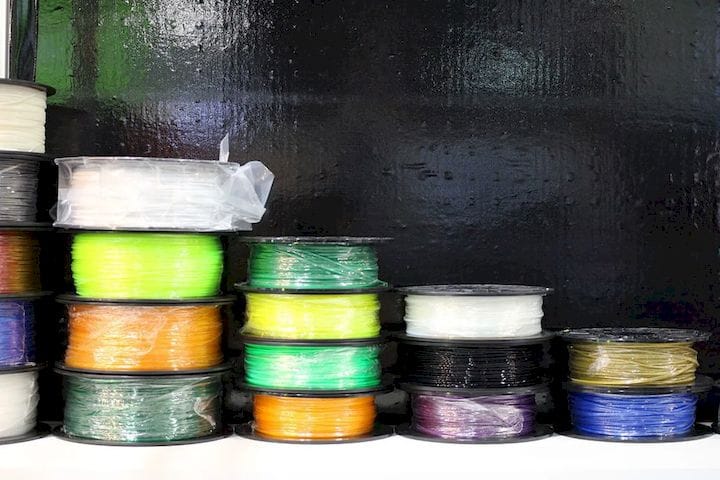![Spools of PLA filament for 3D printing [Source: ENGINEERING.com]](https://fabbaloo.com/wp-content/uploads/2020/05/image-asset_img_5eb098fd37bba.jpg)
In the desktop 3D printing community, polylactic acid (PLA) is easily one of the most popular plastics.
This is due in large part to the fact that it’s easy to print with, does not emit nearly as many particles as other materials, and is biodegradable.
Usually made from sugar in corn starch, PLA doesn’t carry with it the negative connotations of petro-based plastics, like ABS, but that doesn’t mean that it has no environmental impact. For instance, it may be compostable, but that process is a very slow one if you’re not using an industrial composting facility. In this article, we take a look at some of the larger issues associated with using PLA.
What Goes into PLA
For the sake of this article, we’ll take a look atIngeo-brand PLA, since it is the most widely used brand in the world. Ingeo is manufactured by NatureWorks, which is jointly owned by Cargill, the largest privately owned company in the U.S., and the Thai state-owned oil and gas business PTT Public Company Limited.
While PLA can be made from a variety of plants rich in starch, such as beets and potatoes, you’ll find that the majority of it comes from corn in the U.S., due to the country’s massive corn subsidies. Since Cargill is the world’s largest corn seller, that’s what you’ll find Ingeo is made of, as well. Following NatureWorks, the second-largest supplier of PLA is Corbion, whose Luminy brand is made from sugarcane.
NatureWorks begins by harvesting fields of No. 2 yellow dent field corn, also called “field corn.” What separates field corn from the sweet corn you might find at your local farmer’s market is that it’s grown for industrial purposes. NatureWorks has published a helpful breakdown of what field corn is typically used for, including livestock feed, starch for adhesives and other materials, sweetener, ethanol and Ingeo.
![PLA ecosystem [Source: NatureWorks]](https://fabbaloo.com/wp-content/uploads/2020/05/natureworks-pla_result_img_5eb098fda80b3.jpg)
To create PLA, only the corn kernels are used. Once the kernels are milled, the starch (glucose) is extracted from the corn and enzymes convert the glucose to dextrose using hydrolysis. The dextrose is fermented by microorganisms into lactic acid, the simple chemical result of fermentation. Lactic acid is then converted into lactide, which is formed into long chains (polymers) using a proprietary process called ring-opening polymerization to create PLA.
The Pros and Cons of PLA
3D printing users are likely well aware of the benefits and disadvantages of using PLA when it comes to making parts. It’s very easy to use, adheres to the print bed, and doesn’t deform over the course of a long print, but is fairly brittle on its own, tending to snap under pressure. Since PLA became a mainstay of desktop 3D printing about 10 years ago, filament manufacturers have been mixing it with other materials, such as acrylics, to increase its strength. However, there’s been no mention of how these additives might affect the material’s overall environmental impact.
Unlike the majority of plastics on the planet, PLA is not made from petroleum or natural gas. Given that the production of plastics makes up 1 percent of U.S. greenhouse gas (GHG) emissions and 3 percent of the country’s primary energy use, bioplastics could play a small role in helping to shrink the size of the world’s carbon footprint.
A 2017 study suggested that replacing petro-based plastics with PLA has the potential to reduce GHG emissions by 25 percent. If the energy used to power PLA production facilities was converted to renewable sources, such as wind or solar, those emissions could be cut even further.
All plastics slowly emit gas overtime as they are exposed to the elements (oxygen, sunlight, water, etc.), a process known as outgassing. PLA releases fewer GHGs than its petro-based counterparts. However, according to a 2010 study, bioplastics may release more pollutants as a result of the fertilizers and pesticides used to grow the crops that help make them. NatureWorks allows partners to purchase Ingeo made without genetically modified (GM) crops, but it is not standard practice and, due to the high pesticide resistance of GM plants, they are usually associated with increased pesticide usage.
In addition to the pollutants that can be created by bioplastics, the fertilizers used to grow the initial corn or other feedstock can result in significant GHG emissions. The nitrous oxide used in low-cost fertilizers, for instance, is 310 times more potent than carbon dioxide and 15 times more potent than methane. One calculation suggests that the use of these fertilizers sees NatureWorks create approximately “56 Tg of carbon dioxide equivalent, more than all of the landfills combined in the United States according to the US Gas and Sinks.”
Read more at ENGINEERING.com











An inventive designer has developed a method for producing 3D paper objects using recycled paper and 3D printed molds.